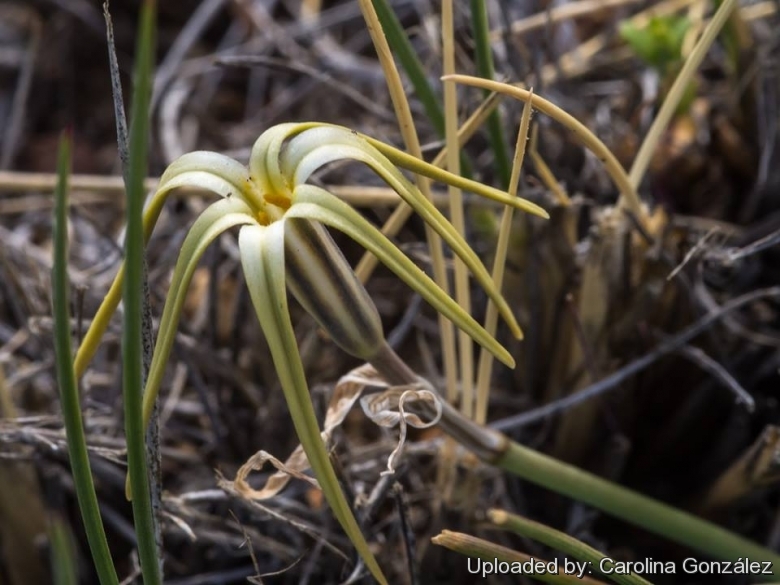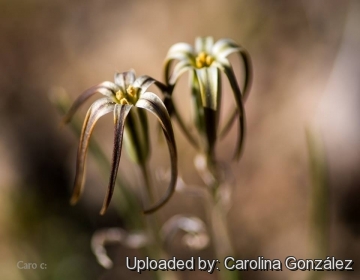
Tristagma ameghinoi Photo by: Carolina González
Origin and Habitat: Patagonia (Argentina) and XI Región, Cerros al sur de Chile Chico, (Chile).
Habitat and ecology: Tristagma ameghinoiSN|33179]]SN|33179]] is frequent and abundant under Colliguaja integerrima bushes.It grows on low slopes of southern exposure and alluvial terraces. It is difficult to detect given the green colour of its tepals, particularly among the foliage of annual grasses such as Bromus berterianus and Vulpia australis, with which it coexists. This species is is considered rare.
Synonyms:
Description: Tristagma ameghinoiSN|33179]]SN|33179]] is a perennial herb 9-20 cm high.
Bulb: Ovoid approximately 16 mm long and 10-12 mm wide, tunicate.
Leaves: 6-8, fleshy, linear-filiform, appearing together with flowers, grey-green, 8-23 cm long, 1-1.4 mm wide, slightly you canalled.
Inflorescence: Scapes 1-3, erect, 5-16 cm long and 1 mm wide. Spathe two valved, 1-2(-6) flowered; valves almost equal, lanceolate, united at base, membranous, 13-15 mm long.
Flowers: Pedicels 14 mm long. Perianth olive green or saffron-coloured, 9-12 mm long and 10-18 mm wide, outer tepals 5.5 to 9 mm long and 0.7-1 mm wide,3-4-times as long as the short tube. Tube 9.5-12 mm long, 2.3 mm wide. Filaments very short, narrow-flattened, slightly
2-seriate inserts approximately 7 mm from the base of the tube, 1-1.5 mm long. Anthers yellow, 2.3-2.4 mm long. 0variy ovoid or oblong-ovoid, 2-2.5 mm long,1.8 mm wide, cells 5-6-ovuled. Style thick 1.2-1.5(-3) mm long. Stigma widely capitate.
Bibliography: Major references and further lectures
1) George Macloskie “Flora Patagonica” The University, 1904
2) Luis Faúndez Y.and Jorge H. Macaya B. “NUEVOS REGISTROS PARA LA FLORA DE CHILE: MAGALLANA PORIFOLIA CAV. (TROPAEOLACEAE), TRISTAGMA AMEGHINOI (SPEG.) SPEG. Y TRISTAGMA PATAGONICUM (BAKER) TRAUB (ALLIACEAE)” Gayana. Botánica Gayana Bot. v.57 n.1 Concepción 2000 <http://dx.doi.org/10.4067/S0717-66432000000100008>
3) George Macloskie “Flora Patagonica” The University, 1904.
 Tristagma ameghinoi Photo by: Carolina González
Tristagma ameghinoi Photo by: Carolina GonzálezSend a photo of this plant.The gallery now contains thousands of pictures, however it is possible to do even more. We are, of course, seeking photos of species not yet shown in the gallery but not only that, we are also looking for better pictures than those already present.
Read More... Cultivation and Propagation: Tristagma ameghinoiSN|33179]]SN|33179]] is seldom grown but relatively easy to grow. It is dormant in summer in the wild, many but grows in areas with year round rainfall and may benefit from some summer moisture. It is certainly a beautifully delicate plant that merits cultivation. Lots of light and good drainage are a must.
Soil: It should be potted in a mixture of peat sand and loam and protected in a cold frame.
Water: Do not over water. In cultivation the slightest careless moisture in the winter produces disaster.
Maintenance: Deadhead the flowers and only keep the seed pods you will require for further propagation of your tristagmas. This will prevent the bulb to age too soon.
Use: They make superb rock garden plants, as well as being perfect for pots and containers.
Propagation: It may be propagated by offsets and probably by seeds. Sow them during autumn, in a mix of equal parts of compost, regular garden soil and sharp river sand. Cover this mix with a layer of sand, distribute the seeds and spread some more sand over them to barely cover the seeds. Place your sowing pan in a cold frame or cold greenhouse if you have heavy rain in your area. If you have snow, place the sowing pan outdoors and let nature do its work. The seedlings can be transplanted once they are 5 cm tall.










